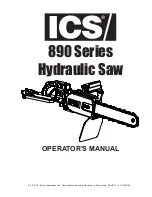
10
TO SERIOUS PERSONAL INJURY. Avoid
KICKBACKS by keeping the blade sharp, by
keeping the rip fence parallel to the blade, by
keeping the riving knife and blade guard in
place and operating properly, by not releasing
the workpiece until you have pushed it all the
way past the blade, and by not ripping a
workpiece that is twisted or warped or does
not have a straight edge to guide along the
fence.
53.
Avoid abrupt, fast feeding. Feed as slowly as
possible when cutting hard workpieces. Do
not bend or twist workpiece while feeding. If
you stall or jam the blade in the workpiece,
turn the tool off immediately. Unplug the tool.
Then clear the jam.
SAVE THESE INSTRUCTIONS.
WARNING:
DO NOT let comfort or familiarity with product
(gained from repeated use) replace strict adherence
to safety rules for the subject product. MISUSE or
failure to follow the safety rules stated in this
instruction manual may cause serious personal
injury.
INSTALLATION
CAUTION:
Keep the floor area around the tool level well
maintained and free of loose materials such as chips
and cut-offs.
Bench mounting
This tool should be bolted with two bolts to a level and
stable surface using the bolt holes provided in the tool's
base. This will help prevent tipping and possible injury.
Fig.1
FUNCTIONAL DESCRIPTION
CAUTION:
•
Always be sure that the tool is switched off and
unplugged before adjusting or checking function
on the tool.
Blade guard
Fig.2
CAUTION:
•
Make sure that the handle cannot be lowered without
pushing the lever nearby the handle to the left.
•
Make sure that the lower blade guards A and B
dose not open unless the lever near the handle is
pushed at the topmost position of the handle.
When lowering the handle while pushing the lever to the
left, the lower blade guard A rises automatically. The
lower blade guards are spring loaded so it returns to its
original position when the cut is completed and the
handle is raised. The top blade guard falls flat on the top
surface after workpiece has passed under it. NEVER
DEFEAT OR REMOVE THE LOWER BLADE GUARDS,
THE SPRING WHICH ATTACHES TO THE LOWER
BLADE GUARD, OR THE TOP BLADE GUARD .
In the interest of your personal safety, always maintain
each blade guard in good condition. Any irregular
operation of the guards should be corrected immediately.
Check to assure spring loaded return action of the lower
blade guards. NEVER USE THE TOOL IF THE LOWER
BLADE GUARD, SPRING OR THE TOP BLADE
GUARD ARE DAMAGED, FAULTY OR REMOVED.
DOING SO IS HIGHLY DANGEROUS AND CAN
CAUSE SERIOUS PERSONAL INJURY.
If any of these see-through blade guards becomes dirty,
or sawdust adheres to it in such a way that the blade is
no longer easily visible, unplug the saw and clean the
guards carefully with a damp cloth. Do not use solvents
or any petroleum-based cleaners on the plastic guard.
If the lower blade guard A is especially dirty and vision
through the guard is impaired, proceed as follows. Fix
the top table at the fully elevated position, raise the
handle fully, push in fully the stopper pin with the handle
fully raised, and use the supplied socket wrench to
loosen the hex bolt holding the center cover. Loosen the
hex bolt by turning it counterclockwise and raise the
lower blade guard A and center cover while pushing the
lever to the left. With the lower blade guard A so
positioned, cleaning can be more completely and
efficiently accomplished. When cleaning is complete,
reverse procedure above and secure bolt.
In the same case for the top blade guard as above
stated, loosen the screw holding it with a screwdriver
and remove the top blade guard. After cleaning, always
reinstall it securely by tightening the screw to the extent
that the top blade guard moves smoothly up or down.
If any of these blade guards becomes discolored
through age or UV light exposure, contact a Makita











































